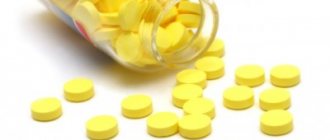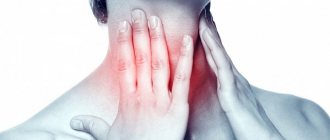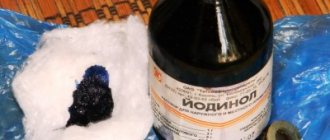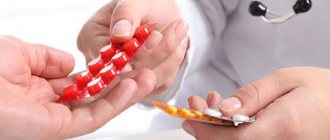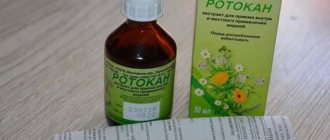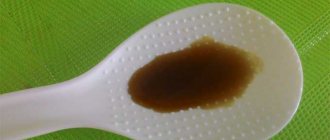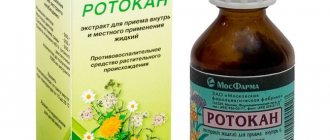The yellow solution called “Furacilin” has established itself as a powerful antiviral drug. The product for external and local use is used for various infectious lesions of the oral cavity and external defects of the body. The finely crystalline powder has a bitter taste, but is odorless, slightly soluble in water and alcohol and completely insoluble in ether. It belongs to the group of nitrofurans.
What diseases does Furacilin treat?
More often, an antimicrobial drug is prescribed when the throat hurts due to seasonal colds. It is recommended when a person is infected:
- staphylococcal sore throat;
- acute or chronic form of tonsillitis;
- glossitis (local inflammation of the tongue);
- stomatitis (damage to the mucous membrane in the mouth);
- gingivitis (infection of the gums).
Furacilin is also prescribed for purulent otitis, conjunctivitis, bedsores, bacterial and fungal infections of the nasal cavity and other infectious diseases.
For sore throat
In acute tonsillitis, the tonsils become inflamed. The disease is accompanied by:
- high temperature;
- sore throat;
- redness of the mucous membrane;
- swelling of the tonsils;
- accumulation of plaque on the tonsils.
In severe cases, infusion therapy is used and immunoglobulins are administered. In acute tonsillitis, purulent plaque always forms in the oral cavity. It is removed mechanically. Rinsing with furatsilin solution relieves pain. The procedure helps to destroy microbes, and the healing process is shortened.
For pharyngitis
Inflammation of the lymph and tonsils is accompanied by a sore throat. Treatment with furatsilin up to three times a day is prescribed to relieve inflammation and acute symptoms along with other antiseptics.
Comparative characteristics of drugs
Chlorhexidine and Furacilin belong to the group of antiseptics.
They have a different range of effects. Furacilin fights well against bacterial flora, but does not help well with viral and fungal infections. Chlorhexidine has a wider spectrum of effects. It can be used for viral, bacterial, and fungal infections of the skin and mucous membranes.
Comparison of drugs
Sign | Furacilin | Chlorhexidine |
| Active component | Nitrofural | Chlorhexidine bigluconate |
| Area of influence | Gram-positive, gram-negative bacterial agents (staphylococcus, streptococcus, Escherichia, clostridia and others). | Sexual bacterial pathogens (neiseria, treponema, chlamydia, ureaplasma, Koch's bacillus, nosocomial strains), viral (herpes simplex), fungi (candida, dermatophytes). |
| Indications |
|
|
| Compatibility of Furacilin and Chlorhexidine | Taking Furacilin together with Chlorhexidine is not recommended. They can only be alternated or replaced with each other. Furacilin cannot be dissolved in Chlorhexidine. Nitrofural does not dissolve in chlorine-containing solutions. | |
Drug analogues:
- Miramistin;
- Hydrogen peroxide;
- Rotokan;
- Inhalipt;
- Protargol;
- Chlorophyllipt;
- Hexoral;
- Octinisept;
- Dioxidine.
How to make a solution of furatsilin
Ready-made liquid cannot always be bought at a pharmacy. More often Furacilin is found in tablets. The treatment regimen, duration, and dosage form are determined by the doctor, and each patient’s prescriptions are different. The doctor takes into account individual characteristics. Usually 1 – 2 tablets are crushed to a powder and stirred in a glass of warm water.
For faster dilution, it is recommended to use boiling water. For stomatitis, pharyngitis, tonsillitis, a solution is prepared to rinse the oropharynx: per 100 ml - 2 mg (1 tablet) of furatsilin. The duration depends on the nature of the localization of the infection. Take a small sip of the prepared product, throw back your head and rinse your larynx for 2 – 3 minutes.
Use of drugs
In children under 18 years of age, Chlorhexidine is prescribed with caution. In pediatric practice, Miramistin is more often used. Furacilin and Chlorhexidine can be prescribed during pregnancy, as well as breastfeeding, if the benefits of use outweigh the harm to the baby. Furacilin can be used in children for gargling, as well as for purulent lesions of the skin.
Use of Nitrofural
You can gargle your throat and mouth with Furacilin. To properly prepare the solution, you need to dissolve 1 tablet of the medicine in 100 ml of boiled water. If you have a sore throat, you should gargle every 1-2 hours. The drug relieves the inflammatory reaction well and also neutralizes pathogens.
Nitrofural is suitable for washing the pleural, abdominal cavity, affected areas with osteomyelitis, paranasal sinuses, and external auditory canal. To do this, part of the substance is diluted with distilled hot boiled water in a ratio of 1:5000. The solution must be boiled and then cooled. Conjunctivitis is treated with an aqueous solution. The drug is dripped into the area of the conjunctival sac (outer corner of the eye). Treatment is carried out up to 4-5 times per day. If the patient has otitis media, then an aqueous antiseptic solution is dripped into the ear canal up to 4-5 times a day.
For purulent skin lesions, lotions are applied. A gauze bandage is moistened in an aqueous solution of Nitrofural and then applied to the damaged area. The bandage is left on for several hours. Furacilin can be used to wash the urethral canal in men and women with gonorrhea, as well as other sexually transmitted infections. An aqueous solution is used to treat the urethra. The procedure lasts 20 minutes. It is allowed to replace the antiseptic with Hydrogen Peroxide, Rotokan, Chlorphyllipt, especially for pharyngitis, tonsillitis, and gingivitis.
Scope and rules of use of Chlorhexidine
The medicine is actively used to sterilize hands in medical institutions (0.05%) and instruments (0.5%). A spray is suitable for hand disinfection. It is easy to use. The drug should be rubbed in for 2 minutes. The solution is used to disinfect thermometers, computers, furniture (1%).
Sanitation of the genital tract, urethra, and bladder is actively prescribed. A 0.2% solution is suitable for this. In gynecology, Chlorhexidine treatment is carried out by a midwife or doctor in the chair. The procedure lasts 20 minutes. For a man, 3 ml of medication is injected into the urethra one time, for a woman, 1-2 ml is used urethrally, and 5-10 ml is used in the vagina.
When disinfecting wounds, you will need a 0.5% solution . It is often used in purulent surgery, as well as in the burn department. The drug is prescribed after operations in ENT departments. It helps prevent the addition of secondary bacterial flora. Dentists advise rinsing your mouth after a pulled out tooth or minor operations on the gums. The medicine enhances its effect when interacting with alcohol-containing substances. An alcohol solution is perfect for disinfecting hands and objects. The antiseptic is used to gargle the throat, nasal cavity, and paranasal sinuses.
Can children rinse their mouths?
Children from the age of six can already independently perform many hygiene procedures, including rinsing their throats. But it is better for adults to be present so that the child does not swallow the contents. If he has not mastered sanitary skills, then antibacterial lozenges are recommended instead of rinsing.
Mechanical treatment is used for a one-year-old baby. From two years old, the baby is given a rinse. A weak solution of furatsilin is taken into a special “bulb” for douching. The head is slightly tilted forward and the mouth is sprayed.
A safe method for treating the oral cavity for children is inhalation with Furacilin. Sessions cannot be performed without agreement with the pediatrician. If approved by a doctor, inhalations are done using a fresh solution each time. Depending on the degree of the disease, the doctor prescribes the number of sessions and the individual concentration of the drug. Its saturation should be low.
Treatment of a runny nose
Increased secretion of mucus from the nasal passages indicates a rapidly spreading bacterial flora, so using an antiseptic in this case will help quickly get rid of this unpleasant symptom.
Application of Furacilin
Faricilin is a powerful antiseptic with pronounced regenerating properties. It is used not only to wash the wound surface; it is also quite effective in treating inflammatory processes in the nasopharynx. You can purchase tablets or a ready-made antiseptic solution at any pharmacy.
Washing the nasal passages with Furacilin solution is quite effective. Thanks to regular antiseptic “showers” for the sinuses, it is possible to wash away all existing bacterial flora, improve nasal breathing, relieve inflammation and speed up the process of restoration of the mucous membranes.
But it is worth remembering that rinsing the nose of children under 4 years old with Furacilin is contraindicated, since there is a high probability of infection spreading not only through the respiratory system, but also inflammation of the middle ear may occur.
The use of Furacilin as drops is contraindicated, since this antiseptic is intended for external use only. If it enters the gastrointestinal tract due to instillation, unexpected adverse reactions may occur.
Inhalation procedures with an antiseptic solution are not used, since Furacilin is not able to affect the mucous membranes of the nasopharynx through steam.
Uses of Chlorhexidine
The drug has bactericidal and antiviral properties, but is not used to treat the common cold.
Inhalations with Chlorhexidine through a nebulizer help quite well in the treatment of lung diseases, but for rhinitis it is best to use its modern analogue - Miramistin.
Trade names
The active substance in known dosage forms is nitrofural (a word synonymous with “furatsilin”). Pharmaceutical companies now produce antimicrobial agents under different names:
- "Chlorhexidine";
- "Kombutek";
- "Lifuzol";
- "Miramestin";
- "Betadine";
- "Antiseptol".
There are also other names. The drugs are over-the-counter and it is recommended to follow general recommendations on storage conditions for drugs and use.
What not to do?
The postoperative period after tooth extraction is 5-7 days. At this time, you need to be attentive to your health, measure your temperature, and monitor for bleeding. If the pain persists for more than 2 days or intensifies (or becomes throbbing), you should contact your dentist.
Over time, healthy tissue forms at the site of the blood clot, but this can be disrupted if the area is not properly cared for. After tooth extraction surgery it is not recommended to:
- Taking anticoagulants because they thin the blood.
- Bathing in a hot bath, visiting a bathhouse and sauna. Sudden changes in temperature can be harmful, as they cause spasms or dilate the lumen of blood vessels. As a result, the pain will intensify and bleeding may resume.
- Rinsing the mouth.
- Drinking alcoholic beverages.
- Smoking.
- Spitting, as this may dislodge the blood clot.
- Treatment of other teeth, including caries, earlier than a week after extraction. As a result, infection can occur, since carious teeth contain many bacteria.
- Strenuous physical activity, especially heavy lifting and bending. This is one of the reasons for increased blood pressure, which serves as a provoking factor for the opening of bleeding.
- Chewing food on the “sick” side of the dentition.
- Active facial expressions. If there are sutures in the oral cavity, they can break and even come apart.
